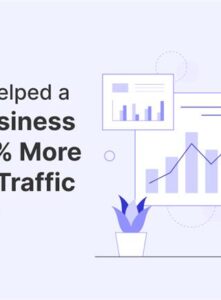Want to Rank on Google? Here’s What Your Website Actually Needs
Table of Contents
- Introduction
- User Intent and Search Behaviour
- Website Speed and SEO
- Content Quality and Keywords
- On-Page SEO
- Mobile-Friendly Design
- Link Building
- Technical SEO
- Tracking Performance
- Conclusion
- FAQs
1. Introduction to Google Ranking
All business owners want to rank number one in Google. But the reality is that ranking isn’t as simple as inserting keywords or writing any random blog post. Google doesn’t just rank websites based on over 200 different factors. To really succeed, you need a combination of technical SEO, content plan, and user experience.
If you are asking yourself what your website actually requires to be noticed by Google, this blog will take you step by step through the fundamental requirements.
2. Understanding User Intent and Search Behaviour
What is Search Intent?
The goal of a user’s search query is known as search intent. Websites that meet the needs of the searcher are rewarded by Google.
Informational intent: Users want to learn (e.g., “What is SEO?”).
Navigational intent: Users look for a specific site (e.g., “Kantha Digital website”).
Transactional intent: Users are ready to buy (e.g., “Buy gold trading course online”).
You increase the likelihood that your content will show up in the top results when you optimize it for intent.
3. Why Website Speed Matters for SEO
Google’s Core Web Vitals
Page loading time is now a direct ranking factor. A slow website can increase bounce rates, which signals poor user experience.
Some key speed metrics:
- Largest Contentful Paint (LCP): Should be under 2.5 seconds.
- First Input Delay (FID): Should be under 100 milliseconds.
- Cumulative Layout Shift (CLS): Should be below 0.1.
Faster websites not only rank better but also convert more visitors into leads and sales.
4. Content Quality and Keyword Optimization
Why Content is Still King
Best Practices for Content:
- Use keywords naturally without stuffing.
- Add subtopics, FAQs, and bullet points for easy reading.
- Update old content regularly.
If you are targeting trading, finance, or digital marketing, make sure your blogs include practical insights and clear takeaways.
5. The Role of On Page SEO in Ranking
On Page SEO is the foundation of every high-ranking website. Without it, your efforts will be incomplete.
Some key elements include:
- Optimized title tags and meta descriptions.
- Proper use of H1, H2, and H3 headings.
- Internal linking to relevant resources.
6. Mobile Friendly Design and User Experience
Why Mobile Optimization is Crucial
Over 65% of searches happen on mobile. If your website is not mobile friendly, you lose both visitors and rankings.
Key Tips for Mobile SEO:
- Use responsive design that adapts to all screens.
- Avoid pop-ups that block content.
- Ensure clickable buttons are large enough.
User experience (UX) also includes clear navigation, attractive visuals, and engaging calls to action.
7. Link Building and Authority Growth
Google sees backlinks as a vote of confidence. The more high-quality links pointing to your site, the more trustworthy your site becomes.
Link Building Strategies:
- Guest posting on relevant trading or marketing sites.
- Creating shareable infographics and guides.
- Building connections on LinkedIn, Twitter, and trading communities.
Remember, quality matters more than quantity.
8. Technical SEO and Site Structure
Technical SEO helps Google crawl and index your site efficiently.
Key Technical Elements:
- Submit an XML sitemap.
- Fix broken links and redirect errors.
- Use SSL certificates for HTTPS security.
- Implement structured data (schema) to enhance search snippets.
A well-structured site makes it easier for search engines to rank your content.
9. Tracking Performance and Making Adjustments
The Importance of Monitoring
SEO is a continuous process. You must constantly assess and adjust.
Tools for Use:
Google Analytics for monitoring traffic.
Google Search Console for problems with indexing.
For keyword and backlink analysis, use Ahrefs or SEMrush.
You can determine what works and modify your approach by keeping an eye on the results.
10. Conclusion
Google ranking involves more than just keywords. It blends top-notch content, ongoing optimization, mobile-friendly design, and technical SEO.
If you employ these strategies on a regular basis, your website will rank higher and generate more leads, sales, and brand authority.
11. FAQ
1. How long does it take for a website to rank on Google?
A number of variables, including competition, website age, and SEO efforts, affect how long it takes to rank on Google. New websites usually don’t see noticeable results for three to six months.
2. Which SEO ranking factor is the most crucial?
One of the most crucial elements influencing SEO ranking is the caliber of the content. Google favors well-structured, pertinent, and valuable content.
3. Is it possible to rank on Google without backlinks?
Even though backlinks are crucial to SEO, you can still rank well on Google without them, particularly for keywords with little competition. Building high-quality backlinks, however, will expedite the ranking process.
4. How can I determine whether my website is responsive to mobile devices?
You can use Google’s Mobile-Friendly Test Tool to see if your website is responsive. It examines how well your website works on mobile devices.
5. How can I increase the speed of my website for better search engine optimization?
Focus on lowering image sizes, minifying CSS and JavaScript files, and utilizing caching mechanisms to increase website speed. Google PageSpeed Insights and other similar tools can offer helpful suggestions.


